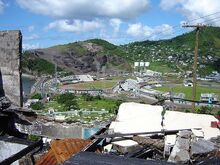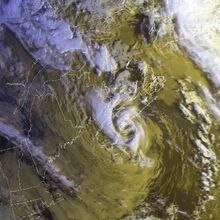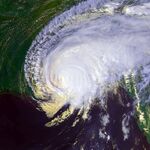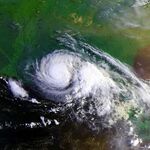The 1994 Atlantic hurricane season was the final inactive season in a series (1991, 1992, 1993, 1994). The season produced 8 named tropical cyclones, with 3 hurricanes. The season officially started on June 1 and ended on November 30. The first tropical cyclone, Tropical Storm Alberto, formed on July 20, while the last storm, Tropical Depression Twelve and Hurricane Helene, dissipated on October 31. The season did not feature any major hurricanes at all (but Hurricane Helene originally attained major hurricane status), just like the previous seasons stated above (except for 1992). The 1994 Atlantic hurricane season was the most active season of the series.
The strongest and the most notable storm of the season, Helene, reached Category 2 intensity on the Saffir-Simpson scale, with peak winds of 110 mph (175 km/h). Excluding Debby, Ernesto, and Helene, none of the storms reached over hurricane intensity. Tropical Storm Beryl produced extremely heavy rainfall and widespread flooding throughout Hispaniola. Hurricane Debby produced a tornado outbreak consisting of 40 tornadoes forming on Alabama. Tropical Storm Florence was the most significant storm of the season, making an unusual track, and making landfall on Cuba four times, killing thousands of people due to extreme flooding.
In addition, over the course of the season, a storm in the Mediterranean Sea formed on November. It was unofficially known as "Cyclone Isaac" by many after the season ended. The storm reached hurricane-strength winds, and made landfall on Greece, causing approximately 120 deaths on different regions and the storm caused $1 billion USD of damages. Cyclone Isaac's impact on Greece introduced the Mediterranean Weather Service on the spring of 1995, which is a weather agency focused on the atmospheric conditions of the Mediterranean Sea and surrounding countries.
Timeline & summary[]

The season was below-average and inactive in terms of tropical cyclone activity. The season is also one of the four seasons that didn't have any major hurricanes, alongside 1987, 1991, and 1993. The first hurricane of the season, Hurricane Debby, reached its peak on August. The low activity of the 1994 season is attributed to the presence of El Niño, which makes the Pacific warmer, and the Atlantic cooler. Beryl and Florence were the first names to be retired without reaching hurricane intensity, and the first names to be retired on List 4.
Activity[]

Sea surface temperatures on September all over the world.
The season was below-average due to an ongoing El Niño event. As seen in the picture on the right, depicts the sea surface temperatures on September globally. The three hurricanes of the season, formed on August, September, and October respectively. (Debby on August, Ernesto on September, Helene on October).
The season had a late start, with the first storm forming on July 20, and also had an early end, with the last storm dissipating on October 30.
Impact[]

Florence's damage to Cuba.
The season was inactive, but featured deadly and destructive storms. Two of the most notable storms of the season were Tropical Storm Beryl & Tropical Storm Florence, which caused almost thousands of deaths on Hispaniola and Cuba respectively. Beryl caused $200 million USD of damages, while Florence caused $1.2 billion USD of damages, being the first tropical storm to gain billions of damage. The strongest storm of the season, Helene, also caused extensive damage to various regions, extending from the Lesser Antilles to the eastern sideboard of United States. Hurricane Ernesto impacted New England as an extratropical cyclone with gusts of 99 mph. Hurricane Debby caused a tornado outbreak on various regions of the United States.
Records[]
Systems[]
The season had 12 depressions, 8 tropical storms, and 3 hurricanes. The strongest storm of the season was Hurricane Helene.
Tropical Storm Alberto[]
| Tropical storm (SSHWS) | |
| Duration | July 20, 1994 – July 28, 1994 |
|---|---|
| Peak intensity | 100 km/h (65 mph) (1-min) 989 hPa (mbar) |
On mid July, a tropical wave moved off the coast of Africa. There was no associated thunderstorm activity located near the wave, until the wave reached the Caribbean Sea, where cloud & thunderstorm activity increased. On July 20, 1994, the first depression of the season formed south of the Hispaniola Island. Due to the combination of unfavorable conditions, the depression did not intensify into a tropical storm in under 2 days. On July 23, despite unfavorable conditions, the depression was upgraded to Tropical Storm Alberto by the National Hurricane Center.
On the following day, Alberto started to weaken as it entered an area with wind shear. Hours later, Alberto was downgraded into a tropical depression. Alberto was expected to dissipate an hour or a day later, but on July 26, Alberto unexpectedly reintensified into to tropical storm intensity. On July 27, Alberto reached its second peak intensity as it made landfall on Alabama & Mississippi. On the following day, Alberto became extratropical, and was declared as an extratropical low by the National Hurricane Center as it tracked northeast.
Alberto's remnants caused heavy rainfall on nearby states, causing widespread flooding. Overall, it caused $100 million USD of damages and claimed 21 lives.
Tropical Storm Beryl[]
| Tropical storm (SSHWS) | |
| Duration | July 25, 1994 – August 2, 1994 |
|---|---|
| Peak intensity | 110 km/h (70 mph) (1-min) 988 hPa (mbar) |
The tropical wave that formed Tropical Storm Alberto, formed a disturbance east of the Lesser Antilles. The disturbance then obtained sufficient organization to be declared as depression. Hours after being declared as a depression, it struck the Lesser Antilles, causing heavy rainfall and widespread flooding on various regions.
On the following day, the depression was upgraded into a tropical storm, and received the name Beryl. Beryl continued to intensify as it headed towards slightly favorable conditions. On July 27, Beryl made landfall on Hispaniola Island. on its initial peak intensity. Despite being a weak storm at that time, Beryl caused catastrophic results to Hispaniola as it executed a loop at the same time. Beryl slightly weakened due to interaction with land after landfall.
On July 30, Beryl reached its secondary peak intensity, and affected nearby regions like Turks & Caicos Islands with its outer rainbands. On the following day, as Beryl reached an area with vertical wind shear, it weakened. It was then downgraded to a tropical depression. On August 2, Beryl made landfall on Georgia, and dissipated afterwards. Beryl caused widespread flooding and heavy rainfall along the Florida Panhandle, Georgia, and Alabama.
Originally, Beryl reached hurricane strength on July 30, but it was downgraded from 80 mph to 70 mph after post-season analysis by the National Hurricane Center. Overall, the system caused $200 million USD of damages, and claimed 1,122 lives on Hispaniola alone.
Tropical Depression Three[]
| Tropical depression (SSHWS) | |
| Duration | August 2, 1994 – August 5, 1994 |
|---|---|
| Peak intensity | 45 km/h (30 mph) (1-min) 1003 hPa (mbar) |
The tropical wave that formed Tropical Storm Alberto and Tropical Storm Beryl previously, coalesced with an upper-level low-pressure system south of the Texas-Louisiana border, and was declared as a depression by the National Hurricane Center on August 2. The depression executed a loop, then made landfall on the following day.
On August 5, the depression became extratropical, and merged with another extratropical system, losing the depression's identity.
Three caused isolated flash flooding on Texas and Louisiana, causing extensive damages and loss of life. Overall, the system caused $600 million USD of damages, and claimed almost 67 lives.
Tropical Storm Chris[]
| Tropical storm (SSHWS) | |
| Duration | August 5, 1994 – August 9, 1994 |
|---|---|
| Peak intensity | 85 km/h (55 mph) (1-min) 994 hPa (mbar) |
In late July, a shortwave trough placed on the westerlies crossed the United States. A system then formed atop of North Carolina. Despite being on land, the system was declared as a depression by the National Hurricane Center.
As the depression moved off the coast of North Carolina, it intensified into tropical storm intensity, and was named as Chris by the National Hurricane Center. Chris started to intensify despite unfavorable conditions. As Chris tracked the east, it started to undergo an extratropical transition.
On August 8, Chris became fully extratropical and accelerated across the Atlantic Ocean. On the following day, Chris made landfall on Europe, bringing heavy rainfall. Hours later, Chris dissipated.
Chris caused heavy rainfall and flash flooding on North Carolina when it formed as a depression. Overall, Chris caused $50 million USD of damages and claimed 13 lives.
Hurricane Debby[]
| Category 2 tropical cyclone (SSHWS) | |
| Duration | August 17, 1994 – August 27, 1994 |
|---|---|
| Peak intensity | 170 km/h (105 mph) (1-min) 967 hPa (mbar) |
An African tropical wave moved off the coast of Africa on early August, and developed into a depression miles away of the Windward Islands. The depression started to organize and gain deep convection as it neared favorable conditions. The depression then strengthened further into Tropical Storm Debby on the following day.
Intensification continued, as Debby tracked northwestwards. Then, on August 19, Debby became the first hurricane of the season. Debby then affected Jamaica, varying from light to moderate rainfall on various regions. On August 20, Debby continued to strengthen further and on the following day, Debby reached Category 2 strength on the Saffir-Simpson scale.
On August 22, Debby reached its initial peak intensity as Category 2. On the early morning of August 23, Debby started to weaken as light wind shear affected the storm. On the same day, wind shear fully dissipated, and intensification continued for the system. On August 24, Debby reached its peak intensity south of the Florida Panhandle and Alabama. On the following day, Debby made its first landfall.
Debby weakened gradually as it neared land, and became extratropical on August 27. Debby caused $800 million USD of damages, and claimed 30 lives. Debby spawned 40 tornadoes on various regions of Alabama and the Florida Panhandle from August 25 to August 26, causing minimal damage to infrastructure.
Hurricane Ernesto[]
| Category 1 tropical cyclone (SSHWS) | |
| Duration | August 19, 1994 – September 2, 1994 |
|---|---|
| Peak intensity | 150 km/h (95 mph) (1-min) 980 hPa (mbar) |
An African tropical wave moved off the coast of Africa on early August and tracked westwards. As the wave tracked westwards, the wave split into two— the big portion being Hurricane Debby, and the small portion being Hurricane Ernesto. The small portion was left behind on the tropical Atlantic Ocean for days as it remained stationary, until on August 19, where periodic bursts of convection occurred on the system, and was declared as a depression later on.
On the following day, the depression reached tropical storm intensity on the Saffir-Simpson scale, and was named as Ernesto. Ernesto maintained its intensity for a while and struggled to intensify despite favorable conditions. On August 21, Satellite & microwave imagery indicated an early indication of an eye forming on the storm, and Ernesto intensifying into a hurricane. On August 22, Ernesto was upgraded into hurricane intensity on 0600 UTC by the National Hurricane Center, and formed a distinct eye.
The small hurricane affected various parts of the Leeward Antilles, with rainfall ranging from light to moderate on different regions. On August 25, Ernesto was downgraded into tropical storm intensity as it neared slightly unfavorable conditions. On August 26, Ernesto reintensified into a hurricane on 0600 UTC. As Ernesto started to execute a loop, it fluctuated between tropical storm and hurricane intensity from August 26 to August 30. On August 30, Ernesto reached its final peak intensity, as it started to undergo extratropical transition.

The extratropical remnant of Ernesto and an extratropical system as one extratropical storm. The extratropical cyclone affected Iceland, the British Isles, and Norway. This was not included on Ernesto's damage totals.
On August 31, Ernesto became fully extratropical. Ernesto raced northeastwards. On September 2, Ernesto merged with another extratropical system, and lost its identity. The extratropical system, known as Windstorm Ernesto, or the 1994 Bomb cyclone, as the system reached an extremely low pressure of 910 millibars. The system caused $700 million USD of damages and claimed 10 lives, but was not included on Ernesto's damage and death total. Overall, Ernesto caused minimal damage, and no lives were claimed.
Tropical Depression Seven[]
| Tropical depression (SSHWS) | |
| Duration | August 25, 1994 – August 25, 1994 |
|---|---|
| Peak intensity | 40 km/h (25 mph) (1-min) 1006 hPa (mbar) |
A non-tropical low located southwest of Bermuda became tropical, and was declared as a depression on August 25, the depression then became extratropical later on and dissipated on the next day.
Seven caused minimal damage and no deaths were reported.
Tropical Storm Florence[]
| Tropical storm (SSHWS) | |
| Duration | September 2, 1994 – September 14, 1994 |
|---|---|
| Peak intensity | 95 km/h (60 mph) (1-min) 995 hPa (mbar) |
On late August 1994, the tropical wave that formed Hurricane Debby, Hurricane Ernesto, and Tropical Depression Seven formed a disturbance located in the Caribbean Sea. Despite favorable conditions, the system was not yet declared as a depression due to having poor organization and a circulation. On September 1, the system had formed a circulation on the storm, and was declared as a depression on September 2.
The depression moved in an erratic fashion, and headed northeastwards. On September 3, the depression was upgraded into tropical storm intensity, and was named as Florence by the National Hurricane Center. On the following day, Florence was downgraded into a depression, and made landfall on Cuba afterwards.
After making landfall on Cuba, the system once again made landfall on Cuba. It was then degenerated to a remnant low on September 6, but regenerated back to a tropical depression on the same day. On September 7, Florence reintensified into a tropical storm, and made its third landfall on Cuba again. It then executed a loop on September 8. On September 10, Florence made its fifth landfall on Cuba again (fourth landfall was on Bahamas). On September 12, again, Florence made its sixth landfall on Cuba (as a depression). Lastly, Florence made its last landfall on Turks and Caicos Islands as a tropical storm on September 13. On the next day, Florence was fully extratropical and became an extratropical low afterwards.
Florence caused $1.4 billion USD of damages ($2,330,206,477.73 on 2018 USD) and claimed 2,355 deaths on Cuba.
Tropical Storm Gilbert[]
| Tropical storm (SSHWS) | |
| Duration | October 7 – October 10 |
|---|---|
| Peak intensity | 105 km/h (65 mph) (1-min) 990 hPa (mbar) |
Gilbert's precursor originated out of a low pressure area along the North Carolina coastline. The low pressure area then was declared as a depression on October 7, as it was located east southeast of Bermuda. Tropical depression warning was issued on the island of Bermuda, but it was upgraded to a tropical storm warning after the depression intensified into Tropical Storm Gilbert on the evening of the same day.
Due to Gilbert's size, it avoided Bermuda, but brought rough surf on North Carolina, Bermuda, and New England. On October 8, Gilbert reached its peak intensity. On October 10, Gilbert became fully extratropical, and afterwards made landfall on Atlantic Canada.
Gilbert caused minimal damage and claimed 2 indirect lives due to rough surf on Virginia.
Tropical Depression Ten[]
| Tropical depression (SSHWS) | |
| Duration | October 10 – October 13 |
|---|---|
| Peak intensity | 50 km/h (30 mph) (1-min) 1000 hPa (mbar) |
On October 10, Tropical Depression Ten formed north of Cuba. Ten executed a loop and made landfall on Cuba shortly after. On October 12, Ten made landfall on Florida Keys, and dissipated on October 13 afterwards.
Ten caused $800 million USD of damages and claimed 200 lives which was most of Florence's survivors.
Hurricane Helene[]
| Category 2 tropical cyclone (SSHWS) | |
| Duration | October 17 – October 31 |
|---|---|
| Peak intensity | 175 km/h (110 mph) (1-min) 950 hPa (mbar) |
On early October, a tropical wave emerged off the coast of Africa. The wave, along with an associated area of deep convection coalesced into one as it reached the Caribbean Sea, and was declared as a depression by the National Hurricane Center on October 17. On the following day, the depression reached tropical storm intensity on the Saffir-Simpson scale, and was named Helene by the NHC.
On October 19, Helene attained hurricane status, and became the third hurricane of the season. On the following day, Helene reached Category 2 intensity on the Saffir-Simpson scale, and made landfall on Cuba. Helene was downgraded into a Category 1 after landfall, and started to form a ragged eye.
On October 23, Helene was reupgraded to Category 2 strength, and started fluctuating between Category 1 and Category 2 intensity. As Helene executed a loop, it reached its peak intensity and made landfall on North Carolina. After making landfall on North Carolina, it was downgraded into Category 1 intensity. On October 30, Helene became fully extratropical, and dissipated above the Great Lakes on October 31.
Originally, Helene reached Category 3 intensity, but was downgraded into a Category 2 after post-season analysis. Overall, Helene caused $1.5 billion USD of damages and claimed 50 lives.
Tropical Depression Twelve[]
| Tropical depression (SSHWS) | |
| Duration | October 31 – October 31 |
|---|---|
| Peak intensity | 40 km/h (25 mph) (1-min) 1006 hPa (mbar) |
On October 31, a subtropical low turned into a tropical low, and became a depression. On the same day, it became extratropical.
Other systems[]

The Mediterranean cyclone unofficialy known as Isaac on peak intensity.
On early November, a small tropical system formed west of Greece. Later on, the system made landfall on Greece. The system remained stationary, causing catastrophic results. After moving to waters, it rapidly intensified and reached hurricane-strength winds. The cyclone started to form a clear eye. The cyclone then impacted Italy. After impacting Italy, it was absorbed by a trough. The infamous cyclone, was dubbed as Isaac. Isaac caused over $1.5 billion USD dollars of damages in total, which caused more damage than any storms of the Atlantic hurricane season. Isaac also claimed approximately 120 lives on Greece alone.

The storm making landfall on Halifax.
On January 1994, a nor'easter formed from a cold front & Jose's remnants east of Maryland. The nor'easter reached hurricane intensity as it impacted New England and Atlantic Canada. The nor'easter was dubbed as Winter Storm Jose, Hurricane Halifax, New Years Nor'easter, and Omega Snowstorm. The storm was popularly known as Winter Storm Jose, as it formed from Jose's remnants. Another popular nickname for the storm was Omega Snowstorm, due to its catastrophic impacts to New England and Atlantic Canada. Overall, the storm caused $900 million USD of damages and claimed approximately 50 deaths.
Naming list & retirement[]
Naming list[]
Under this are the following names used for the 1994 Atlantic hurricane season. It is the same list used for the 1988 season. 8 out of 21 names were used during the course of the season.
|
|
|
Retirement[]
On the spring of 1995, the names Beryl, Florence, and Helene were retired by the WMO, and will be never used for another Atlantic hurricane. They were replaced by Bethany, Fabienne, and Hyacinthe respectively. They will be used on the 2000 season.























